The First Rough Draft
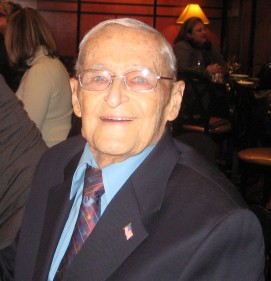
Mac was a little late getting to Willow- but there was a reason. He was getting suited up for a portrait. He drove over from The Madison and parked his champagne Jag in the garage under the restaurant, and arrived just about the same time as I did, shortly after five.
John-with-an-H and Old Jim were holding down the apex of the Amen Corner, and there were a couple nice ladies from the Office of Naval Intelligence at the end of the short end of the bar, near the window, and Jasper and Liz-with-an-S were holding down the business end of the enterprise.

“Sorry,” said Mac. “I got hung up on that video that is going around, the one with the B-29s on Guam. It was exactly as I remember it.”
“I thought you might like it. The story that went with the images was a complete fabrication, though.” Liz-S brought the Happy Hour White down to the corner and topped off the glasses of ONI Ladies. “You look fantastic,” I said. He really did- he radiated energy as he scanned the list of bottled beer at the end of the wine menu.
“Do you have Anchor Steam?” he asked Liz-S. She shook her head, her chestnut ponytale dancing across his slim neck.
“If you like that, you might try a Bell’s” she said. “It is nice and hoppy. It comes from Kalamazoo, Michigan.”
I glanced at Jim and we launched into song- you know the one. Mac laughed.
“I actually have four gals in Kalamazoo.”
“Your daughter and her kids?” I asked.
Mac nodded. “Yep. That B-29 newsreel was something else, no kidding. Did you see Iron-pants Curtis LeMay with that big stogie? Not a word about his asking Navy to provide targeting for his bombers. But the images of those 600-plane raids leaving the island were spectacular.”
Mac was dressed to the nines in a charcoal suit with bold tie and crisp blue shirt, which was part of the scheme. As part of the big kerfluffel over replacing the laptop, I had found a bunch of files on an older computer. One of them was the Admiral’s bio, which we updated, just to have something in place.
I have been very attuned to the number of things that need to be done quickly, in time of need, and this was as good a thing to have “on the spike,” just in case.
I wrote and asked him which picture he would like to have with the article. I have a sideline drafting obituaries for the Quarterly, so I wanted to know which image he preferred. “I like the one they took after Chester Nimitz pinned the Bronze Star on my chest,” he said. “But we probably should have a presentable one of me today.”
“I brought the camera,” I said, waving the little Canon. “Let me get that out of the way before we start having fun.”
I moved over to the other side of Jim, next to the ONI ladies. I have told you Mac is a Babe Magnet, and snapped away. Laura took the camera from me, and started snapping random shots along the bar. Liz-S delivered another Bud for Jim and a Bell’s for Mac. They both smiled in anticipation. “How was the Dining In?” asked Mac. “I was not quite up to it, but I feel great. I even bought a six-pack of Anchor Steam for the apartment.”
“Did you drink it?” I asked.
“No, but I did go back to work at the hospital. First time in more than a year I have felt up to volunteering.”
“That is fantastic news,” I said. “My weekend started out with the Dining-In.”
“How did it go?”
“It was great,” I said. “A super turnout. It is good to have the tradition back.”
“I think you got the date of the first one wrong in your account of it Saturday.”
“I did the math on a napkin, and came up with 1955,” I said. “I could easily have got it wrong,” I said. “This is all a first rough draft of history, after all.”

Mac nodded. “Rufus Taylor was the Director of Naval Intelligence for the first one,” he said. “I came back East from my assignment at First Fleet in San Diego to attend.”
“Wait, Rufus was the first Intelligence Officer appointed Director, right?”
Mac nodded. “Yep. That is why he decided to do something to celebrate the fact that the inmates were finally running the asylum. They held it at The Gun Factory.”
“Is that what you called the Washington Navy Yard?”
“Yep. They had always manufactured cannons there, since before the days of Admiral Dahlgren. But it was official, after World War Two, right up until 1964.”
“The gun factory. Cool name,” said Jim.
“They made all the 16-inch naval rifles for the Iowa-Class battewagons,” said Mac, and then we wandered off on a long discussion of the bigger guns on the Imperial Japanese super battlewagons of theYamato-class.
“There were two of them,” said Mac. “Yamato, of course, and Musashi. They were the largest and most powerful battleships ever built, packing an eighteen-inch main battery- well, actually a little bigger than that. The IJN used the metric system.”
“There were two gigantic shells that framed the entrance to the Service Squadron at Makalapa Crater,” I said. “I always assumed they were from one of our ships, but someone told me they were from the ammunition intended for Yamato.”
“Might be true,” said Mac. “I was involved in sinking both of those suckers.”
“Got a pen?” I asked, reaching for a napkin from the stack in front of me. “I think there could be a story here.”
Mac just smiled. It is great to have him back in battery.
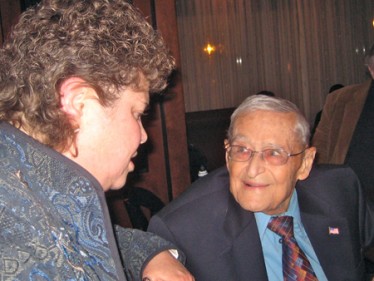
Copyright 2012 Vic Socotra
www.vicsocotra.com
The Long Arm
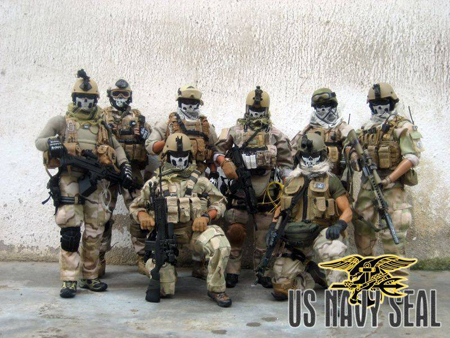 (Rousing picture of imaginary Sea-Air-Land Commando team. Image staged by Nerdpride aka Crazy children.)
(Rousing picture of imaginary Sea-Air-Land Commando team. Image staged by Nerdpride aka Crazy children.)
I am a huge fan of Navy SEALs. The above picture is one that you might have seen in the outpouring of adulation over the raid that killed that scumbag bin Laden in Abbottabad, and the other astonishing demonstrations of cool professionalism.
They shot dead the pirates who hijacked the MV Maersk Alabama and held her skipper, Richard Phillips in a lifeboat. Then they put a period in the al Qaida leader, and last month rescued hostages Jessica Buchanan and Poul Hagen Thisted from some Somali thugs.
The Boys from Coronado and Virginia Beach are clearly on a roll, and God bless them. They have provided a long arm of the law for the Administration, and along with the capable drone-launched anti-personnel rockets, a cost-effective means of dispatching bad guys all over the world. While one might wonder at the implications of this new world, there is no doubt of the courage, expertise and elan of the Special Operators.
I should note, of course, that the picture above is NOT of SEAL Team SIX. It is a very cool image and has been around for several months. It even popped up on one of the professional boards I listlessly copy in the tidal wave of information about things that don’t mean much to me any more. Fooled a professional.
The picture was actually staged by a kid in Malyasia who goes by the handle “Nerdpride aka Crazychildren” with twelve-inch GI Joe-style action figures. If you doubt it, look at the clearly plastic arm of the figure on the right. I saw a caption that attributed the artificial limb as a sort of triumph of Special Operations and the return of a wounded warrior to active service.
You can understand how the SEALs have become an international sensation and a particular source of pride for the American Public who increasingly have no idea who the rough men who do their bidding in the night really are.
My heart goes out to the families of the dozens of Special Operators who were killed when their Chinook was shot down while conducting a rquick response raid in the Tangi Valley last August, or the desperate fight in Operation RED WINGS that took eight SEALS on the slopes of Mt. Sawtalo Sar back in 2005.
If you care, you might want to visit the Foundation established to help the families and survivors of one of the worlds most dangerous professions: http://www.nswfoundation.org/
As we move into a world where America is no longer engaged with heavy forces in Iraq, and is edging towards the door in Afghanistan, the real conflict is erupting in the budget struggle in the Pentagon.
The Services fight each other with implacable determination, but one gets the sense that there is a certain dazed disbelief in it all. The mainstay of the Air Force, the F-22 Raptor, was capped at a fraction of its intended acquisition number. The F-35, supposed to be the low-end of a new F-15/F-16 mix, is in deep, deep trouble.
Can you believe for an instant that rational people are talking about flying the B-52, first flown in 1952, into the decade of 2040? That is starting to scrape a century in the air. It is lunacy.
The Army and Marine force structure is on the block- can anyone imagine sending the Green Machine to Iran? China? The notion seems a bit absurd.
The Navy, bless its head, remains committed to the construction of ships- targets- that are expected to operate for a half-century.
So, with all that, I was not surprised to see that the Administration appears to have come around to the thoroughly Rumsfeldian notion that small, highly mobile and lethal forces are the future of warfare.
The Times of New York this morning saw fit to lead with the story that DoD is going to turn “increasingly to Special Operations forces to confront developing threats scattered around the world.”

(July 11, 2011 – Photo by Win McNamee/Getty Images North America)
Staff reporters Eric Schmitt, Mark Mazzetti and Thom Shanker claim that ADM William H. McRaven, U.S. Special Operations Command, is pushing for “a larger role for his elite units who have traditionally operated in the dark corners of American foreign policy.”
The argument is that re-wickering the Unified Command Plan would give special operations forces more autonomy in responding to crisis situations around the world, and loosen the death-grip of authority that the regional Combatant Commands exert. The term of art is “supported command,” vice “supporting command,” and the proposal is intended to provide more flexibility to policy-makers.
These things do not happen in a vacuum. Admiral McRaven ran the operation that got bin Laden when he was commander of the Joint Special Operations Command, and clearly everyone in the chain of command (with the possible exception of USCENTCOM) liked the way the operation got results.
The Times ominously notes that the change would permit SOCOM to expand into regions in Asia, Africa, and Latin America, where it has not had a major independent presence.
They won’t under this change, either, but it is clear that the idea of lighter, faster and lethal has come around again. We ask a lot of our Special Warfare people, and for the moment, that may be the force mix we can both afford and need.
But of course, we never get the next war right, and probably are not going to this time either. I remember how gratifying it was to have the Abrams Main Battle Tank in the inventory when Uncle Don Rumsfeld was telling us that we no longer needed heavy forces.
I concede that we have to change and get smarter about what we can afford, and what the future force must provide in terms of capability to implement the national security strategy of the United States.
I am going to donate some money to the SEAL Foundation. These warriors have given beyond the last full measure of devotion.
From what I can tell, they are going to be busy for a very long time.
Copyright 2012 Vic Socotra
www.vicsocotra.com
The Place Next Door

I’ll be jiggered. The new computer demands I enter a “product code” to use the copy of MicroSoft Word for Mac I have owned for years. I forgot the adapter for the camera, and can’t get access to the dozens of shots of the property I looked at yesterday.
I am down on the farm. I have been interested in checking out the 27-acre property that begins on the other side of my northern fence-line since I saw the ReMax sign in the gravel driveway last summer. Then The Process in Michigan diverted my attention. the place was still for sale when I got back to the farm after the uproar, and I decided to check it out.
I don’t know what I am thinking; maybe for only another the cost of a minor mortgage I might be able to put together a complex that could feature the desired flat space for an arena and gain another twenty acres of lush fields of Culpeper green grass.
The abundance of that rich green caused JEB Stuart to proclaim it was the best place to pasture his horses in Virginia, and hence, the world. I don’t know precisely what I would do with it, but it seems like it is at least something to check out.
I got out of town only to get smacked. There were ominous low cotton-wool clouds the color of cold ahead. The front and I collided at Haymarket, and I headed through and then south of a blast of ice and snow and fifty knot winds. It had been sunny and in the 40s when I left Arlington; it was frigid as I parked on the black gravel T of the rutted driveway. I climbed out of the Bluesmobile to greet Phil-the-Realtor. The temperature had dropped ten degrees and I wished I had snagged my gloves out of the trunk where they had been since I got back from Michigan.
Phil was a tall and not thin guy- I thought of him as tight end a little past prime, and all Country.
I was a couple minutes late due to the mini-blizzard, but he demurred, happy to have a prospect even if it was an uncertain one. The price has come down twenty grand on the place, and I had to wince at the consequences on the value of mine. We we shook hands outside the angular jumble of the 1910-era farmhouse.

As an aside, the Police Cruiser is now approaching 90,000 on the odometer, and I had been toying with ideas to replace it. I know the logical thing is to lean things down, but the swirl of life seems to argue that you should have fun where you find it. There is an eternity of time to do nothing at all.
The most logical replacement vehicle would be a Subaru Outback, America’s #1 alternate-lifestyle favorite vehicle, but I was really entranced with the Caddy SRX and the Merc GLK-350 I clocked up a couple thousand miles on each of which lately, the cause of which motoring is directly related to The Process.
I realized, as I always do when behind the wheel of that massive Ford that the Cruiser was the ultimate exemplar of its kind. There will not be a sedan of its utility and raw force to patrol the nation’s highways. Live with it a while longer, I thought, and turned on a buttonhook pattern with my guide to approach the house.

Phil demonstrated that new technology is coming to the industry- he had a CAC-Card-like device with a chip in it to access the key to the place.
“The lady who owns it is away,” He said with a plagematic look, and we walked the first floor. The floors were plank, painted, and you could see where the families that had lived in this place and farmed the red dirt had added on when and where they needed space. The was some dark polished wood in the parlor, for that is what the place had, and one bath in Pepto-Bismol pink.
Phil seemed to regret the color, but it represented an upgrade from whatever claw-footed porcelain tub and john had been there. Had there been an outhouse back in the day, I wondered? We climbed the solid stairs to the second deck. The art suggested the woman who lived there was
The three bedrooms were spacious, and two of the front rooms had yellow Post-It notes informing us these were “cat free” zones. There were no cats in evidence, and I wondered if this is the place to which Heckle the Feral Cat had decamped to for the winter.
“So, the place used to be larger,” said Phil, producing a plat of the land that runs up to Happy Acre Road and follows the stream back down to intersect with the foot of Refuge Farm. “The lady got divorced eight years ago, and she and her husband split the property.”
“Is the husband still here?” I said, marveling at the notion that you could split up a farm and live within sight of your Ex. People are connected to their land down here, and eventually return to it.
“I don’t know,” said Phil. “I just know what she tells me. She is staying here until the place sells, then she is moving to Colorado to be with her daughter.”
We walked the fields with the plat in hand, the chill wind cutting at my exposed hands. We looked at the detached shop, the original solid cement-block well building, and the ramshackle barn and run-in stalls. I took as many pictures as I could, and when we had walked the fence line in the crusting of white above the rich grass, I thanked Phil profusely.
“I gotta ask the question,” I said. “Would the lady consider fractional sales of a pasture or two?” Phil said he thought it might be possible, and would pass it along, a proposal to mutate the property to meet the requirements of the moment.
I waved farewell to Phil as he locked the place up again, and I bounced over the ruts at the end of the drive and turned left to get to my driveway and snag the mail that had piled up since my last trip.
It is so tranquil at the farm. I spent the hours of remaining daylight curled up on the couch, reading and listing to the radio. The new computer has a few glitches that will work out in time, and I read a note from a shipmate who has pulled the plug on the Mainland. I had not heard a lot from him, and I did not know if he was traveling, dealing with the passing of his parent’s generation like me.
Turned out it was something else- a vision thing- and I winced at his business-like description of what it is like to have the Quacks dive into his eye- the window of the soul, I am told. He is getting better, which is the good news, but it is part of something inexorable and vast as forever.
I marvel at The Process we have been so busily been experiencing of late, between friends and family, and the passing of a generation. We move up in the banana clip of life as the shell above us is stripped from the breech and discarded. I feel the sense of being chambered now, waiting for the next adventure..
This has been an interesting couple years, hasn’t it?
Balanced with it is the remarkable end of the process, the return to entropy. I will not be able to look at The Reaper quite the same way going forward. The Disintegration is so hard, but it appears there are choices and chances in the passage that verge on the miraculous.
Verge?
Hell, they are.
Copyright 2012 Vic Socotra
www.vicsocotra.com
The Forty-Fifth
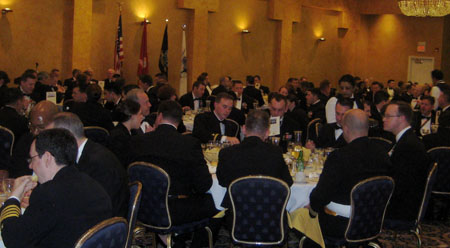
Sorry- little slow out of the gates this morning. The Big Dining In was last night over at the Fort Myer Officer’s Club.
The grand tradition had come down a little in the world since they began. I went to the cupboard to see when the last one was held- the latest wineglass I could find in there is dated “Naval Intelligence Dining In-2008.”
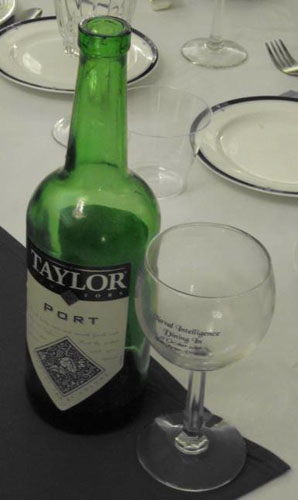
(A bottle of port and commemorative wineglass from the 44th Dining In.)
I don’t know if there was another after that, and I have been to so many of them that they all blur together. But one tradition had come down through the years. The junior officer detailer was tasked with ordering the hundred-odd glasses, procuring the sound system, and transporting the flags. Then, the Bureau of Personnel got BRAC’d to lovely Millington, Tennessee, and one of the poor kids in the DNI’s front office would get tagged with it.
Then the job of organizing it migrated out to Suitland, to the Office of Naval Intelligence, and they began using the Spaetz All-Hands Club at the Post. They were still great gatherings, and one of the best I ever attended was held there, with RADM Mac Showers in attendance.
I just went to my files to make sure. 2008 was the last year they held a Dining-In.
You what those things are. The tradition comes down from the Royal Navy would hold formal dinners with speeches and toasts for just the ship’s wardroom. That was adopted by the US Navy, and in 1955, by Naval Intelligence as a means of building camaraderie and instilling an espirit de corps in a group whose profile by necessity stayed out of the limelight.
That tradition continued and intensified down though the years, and became a sort of trial by fire for the hapless officer who had to organize the thing, and for the Director of Naval Intelligence who was President of the Mess. Another tradition was integral to all this. Normally, precedent dictates that the junior member of the Mess serves as the Vice President- “Mr. Vice,” in naval parlance. That can result, if applied by lineal number, in a really green ensign or a crusty old Limited Duty Officers, either of which individuals could introduce unwanted variables into the conduct of the ritual.
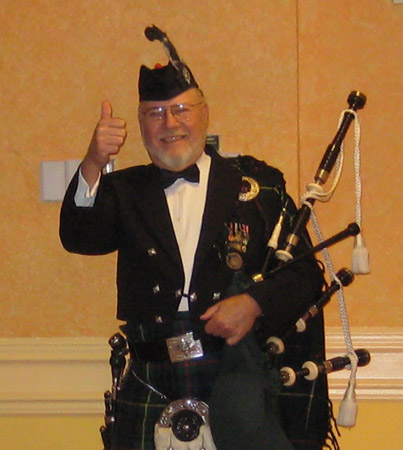
(A tradition ended. The Last Piper, from the 44th.)
And ritual it is. We used to have the same Piper- I have his picture someplace- every year to play “Scotland the Brave,” and lead the Parade of the Beef. There were silver glasses to offer him a tot of Scotch for his services, and senior officers peering intently to see how close to perfection the rite could be conducted, and which of the junior officers were making perhaps a tad too merry.
This was serious business in the Cold War, after all. That got better down through the years, the dinner becoming lighter and less a matter of career suicide.
There have been other tectonic changes in how the Department does its business. Times are hard in the budget world, and consolidation is as inevitable as is the inability of a two-hundred-year-old organization to socialize it.
The last Director of Naval Intelligence- that was when the letters DNI meant that- was selected because the Chief of Naval Operations wanted to streamline his support and special duty communities. I mean, it sounds rational, you know?
I have talked about the Radio Wars before, the struggle between groups of officers to control the flow of intelligence. The Operators- the Airdales and SWOs and Bubbleheads- never understood why their needed Cryptologists and Intelligence Officers. They did understand Weather Guessers and glib Public Affairs Officers, but why not roll them all together into one bag? It is all information, right?
It makes sense, I suppose, if you don’t understand that people have been fighting for careers behind the green door since Mac Showers was an Ensign. The Last DNI was directed to tell everyone to just shut up and sit down and get on with forming a single line entity called “The Corps of Information Dominance.”
It took a lot of bludgeoning of ancient organizations to make it happen, and there were some bruised feelings along the way. For my part, I was relentlessly upbeat. The change was going to come, and I think you have to make the best out of the situation. I still had to stay engaged with what was going on, since I edit the journal of the Naval Intelligence Professionals in a desultory manner, and the Dining In was always an entertaining was to fill up a few pages with pictures and some light-hearted banter that is in opposition to what people do in their day jobs.
Accordingly, when the Last DNI decided that there was enough chaos that the relic of the Dining In was a luxury he wasn’t going to support. 2008 was the forty-fourth Dining In, and that was it.
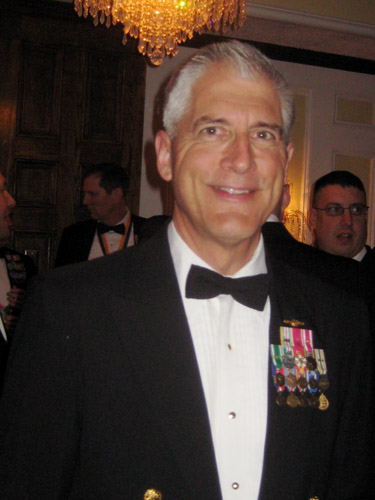
(RADM Tom Meek.)
RADM Tom Meek decided to change that. He is not the DNI- he is the senior uniformed officer at the National Geospatial Intelligence Agency- but he thought it was time to bring back the event as a moral-and-team-builder for Naval Intelligence. Word flew around the community a few months ago: it was going to be like old times. The formal majesty of the Fort Myer O Club was going to be the venue. A distinguished speaker was engaged. The active and retired communities were pulsed to encourage attendance.
I took my tux to the office so I could change there and go direct to the Post. The civilian rig is not nearly so impressive as the short little mess jacket with the miniature medals and staff identification badges and bright gold rings of rank on the sleeve. But that is OK. I drove the Bluesmobile onto the Post with the express intent of having a positive attitude, and keeping my mouth shut.
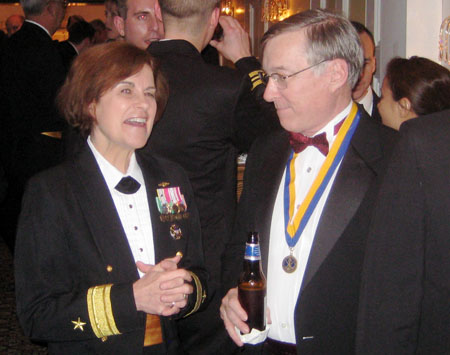
(Jake and Liz.)
Turned out to be one of the best efforts in years, and a pleasure to attend. The young officers are clever, good-looking and optimistic. There were no less than five former Directors there, a host of serving flag officers, and a veteran group of combat-experienced mi-grade officers.
There was a decent leavening of retired farts like me, enough to ensure there was continuity between the generations. With the war over in Iraq, some of our legends were back stateside for the first time in years, trying to figure out what life is like outside the Green Zone. It has been a long way, I thought.
I was impressed by who turned out, and I took a bunch of pictures.
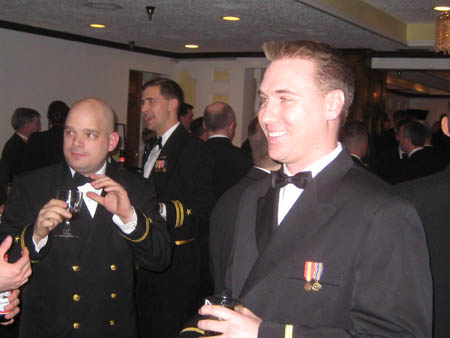
(Ensigns)
The atmosphere was light, and started with a social hour in the Lamplighter Room. The Mess was called to order and we all trooped upstairs to the Koran Room where the banquet was to be held. Old tradition met new. A hiatus of a couple years in an organization that turns over its personnel every two or three years is the equivalent of creating institutional amnesia, but Tom Meek carried it off with aplomb.
The beef was paraded to the rattle of a snare drum. Mr. President was very much in charge, and he kept things on pace. The Grace was provided by the Chief of Chaplains himself, an old shipmate of Tom’s.
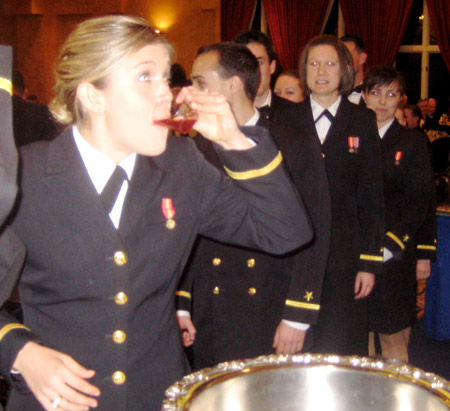
A Grog punch was missed up by the Detailer, and consumed by the Ensigns from Suitland and the Navy-Marine Corps Intelligence Training Center.
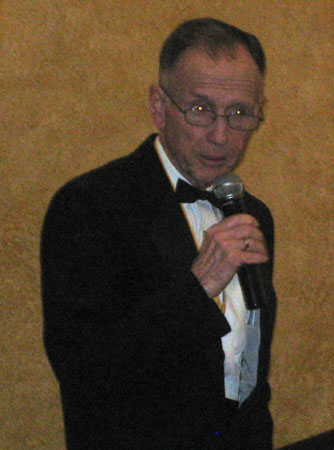
RADM Tom Brooks, one of the great holders of tradition, read the list of honorees for various awards who would have been recognized at the Dinings-In deferred.
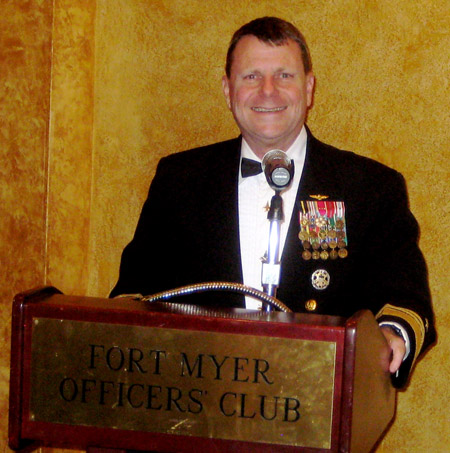
(VADM Bill Gortney, Director of The Joint Staff)
VADM Bill Gortney was the guest of honor, and he is an operator’s Operator, having flown over 5360 mishap free flight hours and bagged 1,265 traps in the A-7E Corsair II and FA-18 Hornet.
He was a little surprised to be called to make his remarks while the salad was still on the table, but he was nothing if not game, and his remarks praising the value of the craft of intelligence to the operational art were succinct, funny and on target.
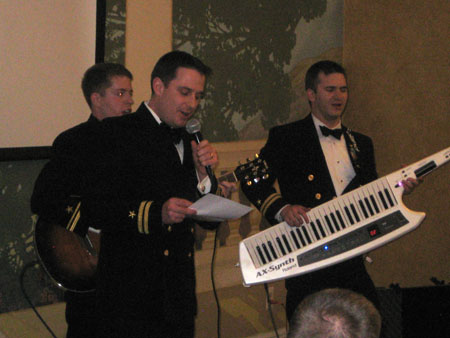
Skits from the schoolhouse, the CNO Intelligence Plot team and a game-show panel of crusty 06s versus a team of Ensigns came fast and furious. Tom summed things up nicely: there are some challenges in how things are unfolding, but this is a proud and honorable calling in a remarkably talented and dedicated band of brothers and sisters.
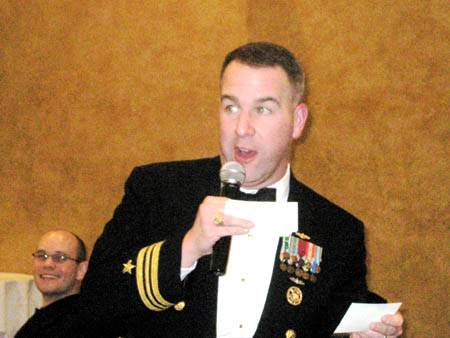
(Mr. Vice delivers a zinger.)
It was awesome.
Normally, the dining room empties out quickly and the younger officers head out to the bright lights of Old Town or Ballston. No one appeared ready to leave the company, and the Koran Room was still jammed an hour after dinner. Out of politeness, some of the Lieutenants asked if I was going to go on the town with them.
“I think I will take discretion as the better part of valor,” I said. I saw Ted Sheafer was smoking outside with another officer who puffed one of the other traditions- a fat Cuban cigar. We talked about the last time the Navy consolidated the intelligence corps, and what a disaster it was.
“Do you think it will be like that again?” I asked.
The Admiral shrugged. “I don’t know. The last time, only the close relationship between CNO Bud Zumwalt and his intelligence guy Rex Rectanus saved the situation. He used to ask who his Director of Naval Intelligence was, and he couldn’t get a straight answer. He put Rex back in charge, and things were pretty good after that. Now, I don’t know. We will just have to see how it goes.”
“Nothing new under the sun,” I said in the full darkness. Then I offered my respect and motored back to Big Pink sedately. Times have changed, I thought. I don’t know if it is for the better or not, but I sure am impressed with the people who are standing The Watch for the rest of us.
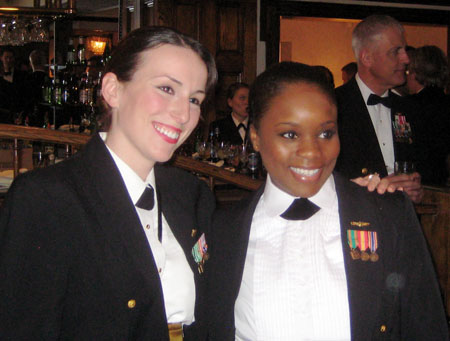 (Lieutenants. All photos Socotra.)
(Lieutenants. All photos Socotra.)
Copyright 2012 Vic Socotra
www.vicsocotra.com
Old Detroiters
There is a hysterical take-off on Clint Eastwood’s Chrysler-commercial from the Superbowl going around. Clint was apparently surprised by the reaction to his spot about the come-back of the auto industry. Apparently they shot it in New Orleans, with the Crescent City standing in for the Motor City for reasons best known to the makers.
The noir atmosphere evoked his great film Gran Torino, in which an aging Koran War Vet and retired autoworker takes on the Gangs of Detroit, who are apparently all Asian, but it was still a great movie. Anyway, Clint is a Libertarian and did not have an overtly political message about the come back of the baled-out Fiat-owned
MoPar corporation, but some took it that way.
I liked it. Detroit automakers are back on their feet,showing their best profits in years, but good news for the state of Michigan isn’t reflected in the sad state of Detroit. The Motor City’s finances are worse than ever.
The city won’t have enough money to pay its bills by April,unless Mayor Dave Bing can get the council and municipal unions to agree to an agenda of steep spending cuts. By the end of its fiscal year in June, my poor bedraggled and defiant home town will have a budget shortfall of $45 million.
There is also the possibility that the state may take over the city, which would open the door for Detroit to file for bankruptcy. That would make it the largest U.S. city ever to suffer that fate. We will talk about all that as it happens. Instead, let’s think back to some things that Clint did not mention. He is certainly old enough to remember the Old Detroit, and to a scary degree, so are we.
Remember these things?
You took a ‘moonlight cruise’ to Bob-Lo with Captain Bob-Lo or went to Edgewater Amusement Park.
You shopped at Hughes and Hatcher, B Siegel, Peck and Peck, Himelhochs, Robert Hall, Crowley’s, Shoppers Fair, EJ Corvettes or Federals and, of Course, Demery’s.
You remember a J.L. Hudsons Department store in your neighborhood, or the flagship store downtown and an ice cream sundae at Sanders.
You remember Twin Pines Dairy delivered milk and juice to the chute on
the side of your house and Milky the Clown performed magic with the magic words ‘Twin Pines.’
You remember Olympia Stadium.
You remember when Vernor’s was made on Woodward Ave., and a bearded dwarf was on the bottle.
Your Mom saved Holden Red Stamps, S&H Green stamps,or Gold Bell Gift stamps, and you licked them into those little books.
SS Kresge’s and Woolworth’s were ‘Five and Ten Stores.’
You know who Bill Kennedy is.
You saw the Detroit Lions play football in Tiger Stadium.
You remember Black Bart and the Faygo song. Or how about ‘Which way did
he go? He went for Faygo, old fashioned root beer!’
You told Mom “Don’t cook tonight! Try Chicken Delight!”
You watched Rita Bell’s prize movies in the morning.
You remember Jack LeGoff and Van Patrick and Wolf-Man Jack.
You remember Milky the Clown, Soupy Sales, Johnny Ginger,Poopdeck
Paul, Captain Jolly, Sagebrush Shorty and maybe even Sergeant Satko Salute.
You visited the Wonder Bread Bakery and got to take home a mini loaf of bread.
You remember ‘Get on the right track at 9 mile and Mack,to get the best deal in
town. Roy O’Brien, it’s the best deal in town.’
You remember going to Detroit Edison with your Mom to exchange burned-out light bulbs for new ones.
(The old downtown J.L. Hudson’s Department Store.)
Copyright 2012 Vic Socotra
www.vicsocotra.com
Shanghaied
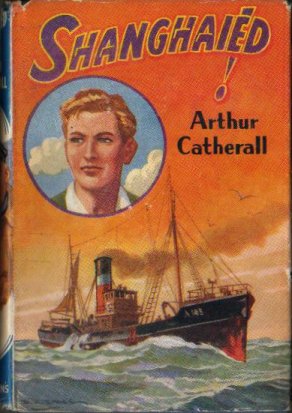
There is an old tradition in the seafaring world of rounding out your roster of able-bodied seamen by slipping them Mickies or knocking them over the head. The sailors would rise in aching confusion in the morning with the ship underway and no escape possible. The Royal Navy would do the same thing at sea- “impressing” sailors from vessels detained on the high seas to fill the deleted ranks of their crew.
Ashore, the tradition was forever associated with the Chinese port city that lent its name to the practice of nautical kidnapping: Shanghai became a verb.
I liked Shanghai a lot when I finally got there. Before that, back in the day, traveling on the train in the New Territories of Hong Kong, there was an ominous announcement that used to be broadcast in the compartments that you were approaching the frontier, and that you had better get your ass off the train before the ChiComs boarded the cars, since the train went on to the curiously Western-appearing city of commerce up on the Huangpu River.
The Bund- the old European Banking District- feels just like home, and there are houses in the English Tudor manner and others in the Swiss Chalet style, and fabulous Art Deco buildings that remain from the bad old days.
I mention that because the FedEx people were kind enough to send a tracking number for a recent purchase, which apparently left some sweat shop in that very city yesterday. The box will travel across the South China Sea to a FedEx hub somewhere else- perhaps via the former Naval Air Station at Cubi Point in the Republic of the Philippines- before landing in the Continental United States and arrive at Big Pink within the week.
The piers of Subic Bay were close aboard the airstrip, and that was where where the big decks could pull in. The base was a wonderful place, not to mention the dubious pleasures of Olongapo City across Shit River from the West Gate. Subic was everyone’s favorite port visit, back in the same day when Hong Kong was still a Crown Colony.
At Cubi, the Seabees moved enough dirt to create the 10,000 foot airstrip to rival the amount dredged to create the Big Ditch of the Panama Canal. a
I was thus dealing with the current controversy about the Apple Corporations merciless exploitation of the Chinese worker in the context of the former ruthless exploitation of the workers- male and female- of the Republic of the Philippines.
My personal involvement in this chain of shame is the procurement of a new laptop computer.
As I may have mentioned, I am a cult follower of the Apple Corporation, and I regret that the pristine white case of my old MacBook had become so stained with the grim of my palms that I was driven to clean it up last Friday night after getting home from the office.
Apparently I overdid the enthusiastic scrubbing of the old Apple, and when I logged on the next morning (thinking overnight would be sufficient for any residual moisture to have evaporated) the number keys on the keyboard had gone non-functional, followed shortly by mysterious stutterings from the hard drive. “Well,” I thought, “It is three years old anyway, and time for a new box.”
So, MacBook Pro it is. I am on the back-up computer that goes back to the transition period from PC to Mac- the second Mac Mini. It is still cool enough that I am thinking abut replacing this box with an iMac, since this one has not kept up with the times, and will not stream video due to an increasingly obsolescent operating system.
Gotta have that, right?
Of course, that was the whole reason for that ill-fated legislation to protect America’s Hollywood intellectual property from being Shanghai-ed by unscrupulous overseas predators. Like Apple, you know?
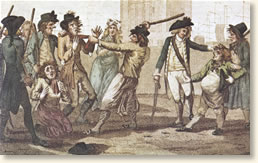
(Consumers beg impressed with the new Apple line.)
Copyright 2012 Vic Socotra
www.vicsocotra.com
Russians
 (Katia, the almost former Willow bartender. Photo Socotra.)
(Katia, the almost former Willow bartender. Photo Socotra.)
The office was quiet, with the exception of that Maxim the Russian who is desperate to build his business and who came to talk to me with his eerie pale blue eyes. He looked a little like Vladimir Putin, and I told him I missed the old Soviet Union a little bit.
“They were a great and worth adversary,” I said, buying some time and trying to figure out if I could use his company in the team we have assembled to work the new huge contract that hasn’t been awarded yet. “Not the regime, of course, but the people of the of the Soviet Union were indomitable in adversity.”
The contract is a topic of periodic unease- I mean, I think we are going to win. There is no indication that we won’t win.
“I have Top Secret clearance,” Maxim said. “You can check in JPAS.”
“There is no reason you wouldn’t qualify, if they conducted the background investigation properly” I said. “That war is over. I like Russians.”
Still, talking about plans for the future is a little strange, since the long wait for the award has combined with everything else to make life a little surreal. The Russian eventually beat everything to death, and I assured him I would be happy to have the non-disclosure and Teaming Agreement paperwork sent to him.
He went away after a while, and naturally I thought of Svetlana, the dark-eyed lady who used to handle our subcontracting. She was from Crimea, and left the Soviet Union from Moscow, as Maxim did when the getting was good after the Wall fell. She had a Top Secret clearance as well, which was useful, but I never completely got over her rich smoky accent on the phone talking about contractual nuances with the Agency we support.
I was sad when she left. We need more Russians in the business, at least on our side.
I was thinking about that as I glanced at the clock and saw there wasn’t enough time to start anything else new. The sun is staying up until six, and it seemed like a decent idea to wander over to Willow and see who might be there on a Monday.
Old Jim was there, naturally, anchoring the Amen Corner. I saw lovely Liz-with-an-S and Katia in the back. I remembered her family was from Byelorussia- we could never quite figure out how her grandfather had escaped the Kommissars after doing some hard time in the Gulag, but her family came here not long after the war. Her mother is a big-wig at the Federal Aviation Administration, and she has been hoping to get her life started and get out from behind the bar.
Jim took his earbuds out and carefully wrapped the cord around his little MP3 player. “Good news and bad news,” he said.
“You mean about the Superbowl?” I was disappointed there was no wardrobe failure.”
Liz topped up my glass with an impertinent Chardonnay. “M.I.A. flipped off the camera, though,” she said. “And dropped the S-bomb.”
“I watched it but did not catch anything inappropriate. I thought Madonna was hot,” I said. “I can’t believe how athletic she was.”
 (Robert, Willow’s Sous-chef in a rare idle moment. Photo Socotra.)
(Robert, Willow’s Sous-chef in a rare idle moment. Photo Socotra.)
Robert the sous-chef made an appearance to press the flesh with the regulars. “I thought the Manningham catch on Eli’s second half drive was the most amazing thing I have ever seen,” he said. “Awesome. Purely awesome.”
“Did you know more people watched the half-time show than the game?” asked Jim.” I don’t know how that works. But no, that wasn’t the big news.”
“Was it about the commercials? My favorite was Clint Eastwood and that thing about America starting the Second Half. He could have been Ronald Reagan and morning-in- America.”
“My favorite was the Grandma and the flying baby grabbing the Cheetos from that little jerk in the tree house.”
“What about the post-attack Chevy truck?” said Liz.
“Or the dog that buried the cat,” said Jim. “But no, that isn’t it either.”
“I don’t know why I had the blahs all day,” I said. “I never really got into the day. Except for that Russian guy who came to talk to me.”
“Not surprising,” said Liz brightly. “This is the day of the year that has the most people call in sick. It is going to be a slow night, and we have nineteen people on staff. I am betting they send a bunch of us home. It will be a tomb.”
“I may only have another couple and call it a night myself,” I said. Liz glided away to talk to Deborah the Ops Boss, and the next thing I knew, Katia was sitting next to Jim on the civilian side of the bar in a brilliant crimson dress.”
“Holy socks,” I exclaimed. “Did they send you home?”
She shrugged. “Not enough people to serve tonight. I don’t mind.”
“You look great,” I said. “A Byelorussian lady in a red frock. Life doesn’t get any better.”
Jim took a long pull on his Budweiser. When he was done, he put the bottle back on the bar and said: “That is what I was trying to tell you. The good-news bad news thing?”
“Yeah? So I thought we covered all that.”
“No, you wouldn’t shut up long enough. Katia is leaving. She got her job with the FAA.”
Katia smiled demurely. “I have a contingent offer to go to work with them,” she said. “It is what I have always wanted to do.”
“That is good news,” I said. “But we are going to miss you.”
She smiled. “It only means I get to sit over here, she said.
Jim smiled broadly and ordered her a glass of Happy Hour White. “That is good news indeed,” he said.
 (Katia as civilian. Photo Socotra.)
(Katia as civilian. Photo Socotra.)
Copyright 2012 Vic Socotra
www.vicsocotra.com
Catastrophic Failure
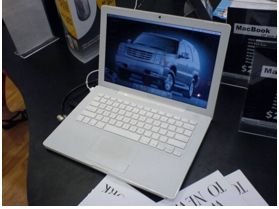
(Rest in peace, my old companion. The Macbook in better days.)
Well, that is what it was, technically, even if the catastrophe actually just meant that I had to fire up the Mac Mini in the guest bedroom where Betty and Bill’s earthly remains look down on me in benign silence.
Still can’t believe that, BTW, a process that lurches from crisis to sudden stillness, bypassing the intermediate steps from Alpha right to Omega. The numbing after-life process- procuring and submitting certificates of departure and insurance claims and Court documents- is a bit of a consolation, as though they were still around.
Mary Margaret lost her Dad not long after Bill and Betty left, he having the same affliction as Bill, so the vibes around Big Pink were pretty somber when she got back from the funeral up in Massachusetts. We have yet to deal with that, and I need to get that on the list of things to do. But enough of that.
Friday night is when I blew up the old MacBook. It has been a faithful device, best laptop I have had. Expensive, yes, and I keep seeing the Toshibas flacking new and lower prices, and Microsoft has rolled out that System Seven thing that is supposed to be not as aggressively stupid as all their other releases since Windows 3.1. That was the last one I really understood.
It might have been a “best value” choice to go back to Bill Gates Evil Empire, but the loss of Mr. Steve Jobs is still too fresh to turn my coat. Plus, it was my fault.
I well recall the glass of wine that teetered and flushed a perfectly good glass of red over the keyboard of my IBM Thnkpad, ending the life of the box that had served me well in my gypsy days. It was a nice piece of work, that box, and I replaced it with another, just as the Chinese bought the division from Big Blue, and rechristened it Lenovo or something.

(IBM T22 laptop, circa 2003, now a creature of the PRC.)
I won’t go back to the PRC for my personal computing needs, that goes without saying, and the next Thinkpad developed cracks around the hinge to the screen, which crackled one evening and blinked out.
It still worked fine, hooked up to a stand-alone monitor, but I figured that sort of defeated the whole purpose of having a laptop in the first place, and the box had to go. I wandered over to the Best Buy in Pentagon City and bought a really cool looking Toshiba Satellite with a 17-inch screen, and that was a pretty slick rig, nice keyboard action and great display. However, the DVD drive failed fairly quickly, and the big screen meant the thing barely fit in my briefcase.
I really should attribute my alienation with that box to the awful Microsoft operating system- I think it went Windows 95, Windows 98, Windows 2000, Windows Me, 2000 Pro, XP and now Windows System 7, with the five in the middle being just plain irritating, vulnerable and clunky.
So, with the Toshiba dying, I took the plunge and recycled the old peripherals into the clinically cool Mac Mini, which I set up in the spare bedroom and began the process of becoming one of those loony Mac people.
I still needed a laptop, and Lucent Technologies and IBM were kind enough to provide company laptops, which made me a little uncomfortable. I mean, there are some things that the company really doesn’t need to have on the hard drive that has to be returned to them, and I have abandoned the idea that superceded personal computing equipment should be recycled. I think the hard drives are best dealt with by removal and physical destruction with a really big mallet, but that is a matter of personal preference.
There is a problem with Macbook, though it is one of esthetics rather than performance.
My young Associate visited last summer, and the first thing she did was get out some baby wipes and attack the laptop with some old fashioned elbow grease.
The serene white surfaces have a distressing tendency to build up ugly discoloration from the palms of the hands, working away, and the screens likewise pick up all manner of disturbing effluvia. She managed to make the Macbook look a little less disgusting, ad Friday night, returning from Willow, I noticed just how bad the laptop looked, as if Mr. Jobs had devised an electronic appliance that was slowly accumulating enough of my DNA to walk off by itself, superceding me altogether.
I thought I did a neat job with minimal moisture, and the computer looked positively pristine. I resisted the temptation to turn it on that evening, but managed to fry the box anyway the next morning in an elegant slow-motion disintegration that commenced with the number keys going inoperable, followed by an endless stuttering of the hard drive and flickering cursor.
Oh well. $1,600 later, the new box should be here by week’s end, and I think I will just let this one get dirty.

(2012 MacBook Pro. Sigh.)
Copyright 2012 Vic Socotra
www.vicsocotra.com
Under Pressure

Boats is one of my heros. He may be the last guy around here who actually understands Admiralty law- which is how he came to be at odds with a certain Department around here, but that is another story.
I convinced him to stop by Willow for a drink even though it is a bit out of the way, and was going to ask him for the blow-by-blow, but Boats is a retired Master Chief, and he talks about what he wants to talk about. He pulled up a stool and looked admiringly at the lovely Liz-with-an-S who was stoking the fires of the happy hour crowd at the Amen Corner of the bar with a fresh Bud for Old Jim, more white wine for me, and a top-off of the red for John-with-an-H.
“You got me going with the pressure cooker article,” he said, contemplating the list of beers at the back of the wine list. “Every once in a while, Daily Socotra opens a flood-gate of fond memories.”
“We aim to please,” I said. “But only once in a while?”
“Don’t flatter yourself,” he said. “And don’t quit your day job. But I had a pressure cooker accident and it may have changed the direction of my life.”
I picked up my pen and sighed. Boats versus the government was going to have to wait, and I copied frantically as he spoke around the Racer 5 Lager that Liz-S brought him, pouring it with a neat white head right to the top.
“From the time I was about 11 until I went off to the Navy at 17 years and 12 days of age, I was a not untypical boy of South Louisiana extraction. Together with my friends Joe and Cy we often made a good deal of cash out of the bald cypress swamp near our homes in the eastern end of Orleans Parish; today the home of the Bayou Sauvage National Wildlife Refuge.”
“However, back in our day the area which we called the “L&N Swamp” was swamp land held largely by various railroads, mostly unposted, utilized freely by fur trappers and commercial crawfishermen. As small boys we were under age for a commercial fishing license and we didn’t have the capital for the boat, motor, nets and other gear for a real commercial fishing operation. So we mostly trapped fur in season with a small sack of steel traps, and trapped turtles and caught snakes for sale to a local reptile farm. Later we branched out to milking water moccasins for their venom which we sold to medical labs.”
“We were always on the look out for new sources of revenue that could be derived from the swamp. One spring, Joe got the idea of making and selling blackberry wine to our fellow Cajun minors. We read a book on wine making from the public library, then cleaned up an old ten gallon fish bowl type aquarium, picked the blackberries in the swamp, and bought a few pounds of sugar. Making a long story short we had a resounding success the wine not only had a market in our illegal trade with our fellow minors, but even some adults in the neighborhood bought it.”
“We had found a source of supplemental income. New Englanders may have invented the term “Yankee Trader,” but Cajuns are simply born free market and free-wheeling capitalists. We no sooner started making money on wine than Joe got the idea that making “harder stuff” would fetch a higher price.”
“Well, it was back to the public library for a while. It never ceased to amaze me how Sister Regina, our eighth grade teacher couldn’t get us to attend class regularly much less undertake anything like a term paper that might lead us to the library, but the opportunity for profit would bring us right in. We found making a still a bit more complex than originally anticipated so Joe suggested that we start small to learn the process. Starting small started with an experiment in making “corn squeezings” in Joe’s Mom’s pressure cooker. These types of activities, of course, could only be undertaken when moms were not present in the house.”
“The opportunity to experiment soon arrived and we started working on our “corn squeezing” experiment complete with pressure cooker. We thought we were near the end of the process and about an hour away from arrival of the duty Mom when the pressure cooker exploded. It did some serious damage to the dry wall and ceiling and splattered “corn squeezings all over the place. We had the cash from our other nefarious activities to replace the pressure cooker, and we were sure that if we could at least clean up, we’d be able to talk our way out of the situation. We were lucky to have been out of the kitchen when the pressure exploded but that was the end of our luck. Joe’s Mom arrived early.”
“The reaction was classic Cajun Mom. We had no need to explain ourselves because we weren’t given any opportunity. She grabbed one of those cast iron skillets and smacked me right up the side of the head because I was closest. Then she took after Joe with the clear intent to kill or beat senseless. The last I saw of the two of them they were running down the street with Joe maintaining a healthy lead, women’s shoes, thank God, just weren’t made to run in the 1950s. My parents were later given a full briefing.”
“My Dad gave me a lecture about legality and ill legality in “business” and the need to distinguish between the two and organize to the maximum extent reasonably possible on the side of legality. I was encouraged to continue my capitalist ways but to be more careful to consider the law. Our turtle and snake hunting and fur trapping activities were given a bit more scrutiny, we were made to quit the commercial fur trapping trade. We had to go straightforward and upright in our adherence to all Louisiana made game and fish laws (there was decided less concern for federal or “Yankee” law). And, we never ventured into moonshining again.”
“Probably, thanks to that blown pressure cooker, I made it to 17 years and 12 days and safely within the proper supervision of the U.S. Navy and later U.S. Coast Guard for my further development as a young man; without the stigma of a felony moonshining conviction, or game law violation. If it hadn’t been for the explosive capacity of a pressure cooker I might have grown up to be a very different person from the military and civil service retiree that I am today. As a Coast Guard Boatswain’s mate and patrol boat coxswain I used my well-honed wetland hunting skills on search and rescue and law enforcement missions. I stayed away from the “hooch distilling” and oyster pirating activities of some of my crew-mates having learned my lessons early.”
“By age 25 I was a Chief Boatswain’s mate, one of the youngest since WW II, a veritable “certified responsible citizen”, though a proud member of the “Hooligan Navy”; as long as no one looked past the date of my original Navy enlistment to view the little poacher and moonshiner who was hatching in the L&N Swamp until a pressure cooker disrupted the first course of my evolution.”
“That is the best pressure cooker story I have ever heard,” I said, putting down my pen next to the unruly stack of napkins. “And I think I am going to need another couple glasses of wine.”
Boats gave me one of those enigmatic Master Chief smiles. “Just stay away from the blackberry wine,” he said. “It can lead to explosive developments.”
Copyright 2012 Boats and Vic
www.vicsocotra.com
The Ignatz Clock, or the Mystery of the Flying Pendulum

Uncle Jim was rarely wrong, but he is here. Above is Ignatz, the brick-throwing mouse from the path-finding comic strip Krazy Kat, drawn by surrealist artist George Herriman in the first half of the 20th Century.
I ran across something on the top of the files in Mom’s excellent library in the Little House on the bluff above the Bay. It was part of the flotsam and jetsam of a long life, and an active and playful family. This was a story from Uncle Jim. It was contained on a couple yellowed pages bound together with a little curious fold of paper, produced by a triangular paper tongue punched with some antique tool. I could tell it was one of Uncle Jim’s informative letters- or what he would have known as a letter, back when typewriters were typewriters, and Xerox machines were still wonders of technology.
He could not have imagined YouTube, I don’t think, but who knows. He was a visionary, and this probably would have fascinated him and prompted another story: http://www.youtube.com/watch?v=qRK0N4AHs4s
Uncle Jim was a master storyteller, and he interpreted technology from an engineer’s perspective. In this telling, “Dad” is our Grandfather, JB, the Western Electric telephone pioneer. I read the words and remembered:
“According to horology buffs,” he started, “the Flying Pendulum mechanism appeared somewhere around Minneapolis in about 1885. It picked up the name “IGNATZ, “ a name later associated with a cartoon cat figure. A rather demented cat.*” It goes and flows from there. I loved his stories, and here is one for you this morning:
“The Flying Pendulum Patent was issued to Adler Clausen of Minneapolis, 09 October 1883. The original clocks were manufactured in 1884 and 1885 only.
At no time could such a clock ever be claimed to be a good timekeeper. Rare specimens, rigorously refurbished, may exhibit departure from correct time amounting to many minutes per hour in erratic fashion. Apparently shopkeepers displayed the because of customer fascination with the mechanism.
In about 1964, an American clock buff arranged to have a facsimile clock produced in Germany which he called the “HOROLOVAR,” and enough were sold to collectors to justify his investment. It was argued that every psychiatrist’s office should have one. It’s weird operation could sooth the most agitated patient, or, failing that, create new business!
I judge that Dad must have seen one somewhere. We never discussed his inspiration to utilize flying pendulum mechanism. His appreciation was to slow down an output power shaft from a coiled spring driver in a simple and cheap manner, where precise regulation of shaft speed was not critical. He had no means ot construct a gear train speed reducer in the classic pattern, and here was a device of simple construction that would meet his requirements.
The specimen of his handiwork that you have (Note: a refurbished model is on the shelf in the library in the house on the bluff above the Bay) operates a simple switch. Dad built this from junk parts salvaged from some spring-driven Western Electric telephone device. It switched between two strings of telephone switchboard lamps that he strung in our earliest Christmas trees, at 20 North 19th Street in East Orange NJ.
Our home had no electricity; lighting was by gas mantles. For Christmas, Dad would rent an automobile storage lead-acid battery to light these Christmas tree lights. And run the railroad trains! Such batteries (6-volt) were not built with today’s quality. Acid leaks are holes in the carpet and stained the parlor flooring behind the Christmas tree, which created some problems with the Landlord. ($20/month rent!). Within days, Dad would have to lug the battery back to the garage for re-charging and the acid holes in his suit brought him some problems from another quarter!
His other device using the flying pendulum regulation was quite similar in construction made from many of the same parts. It was a device for learning Morse Code. Such mechanisms were available in he market, but beyond his price. Code “messages” were toothed patterns cut into aluminum discs about three inches in diameter. Dad somewhere acquired a couple of dozen of commercially-produced discs, which he could fit to his spring-driven mechanism. The toothed discs opened and closed a switch in a battery-powered buzzer circuit by which the student learned to read the Morse Code. Dad’s disc wheels were all in Morse Code, no International Code. Dad never learned the Code. Neither did I!
This device, and discs, is currently in the possession of the Antique Wireless Association Museum in Holcomb, NY, 30 miles south of Rochester.
Dad constructed a second mechanism but without using the flying pendulum regulator. It had a fly ball governor braking mechanism very similar to the speed-control device found in current telephone rotary dials. Speed could be varied over a narrow range. I do not know what became of it; it was nowhere near as fascinating to watch as the flying pendulum mechanism.
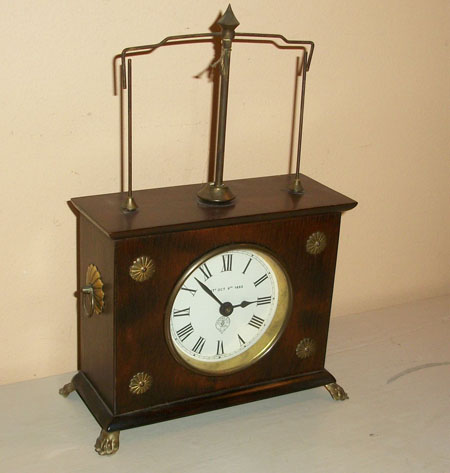
(Model 1964)
Here’s the gadget clock most sought after by collectors and lovers of things different. Often called “Ignatz- The Craziest Clock in the World!” the clock unfailingly draws crowds wherever it is displayed. The reason: it unusual, “top-of-the-clock” tether ball escapement action fascinates all who see it. The Horolovar Flying Pendulum clock is a reproduction of the American original on sale in 1885. The clock provides an attention-getting display for counter, window or home. As a gift for a friend, with imagination it is unsurpassed. (The 1964 mode3l has 11 improvements over the 1961 model, none of which relates to is timekeeping. Each clock is carefully pre-packaged in a sturdy crush-proof carton. Two booklets are included: one, instruction on how to live with Ignatz; the other, a history of the clock and the story of its inventor.
$27.50 Postpaid
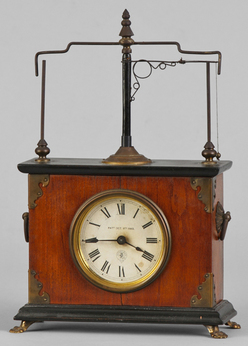
Image of an original “Ignatz “Flying Pendulum Clock. Complete, in good condition except for pendulum arm and wire decoration, both of which have been replaced with modern ones. 7” x 10” x 2 3/4” $260
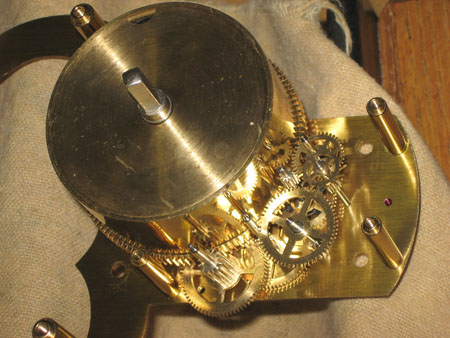
Horolovar spring and mechanism.
“In the above clocks, the center spindle was rotated from a spring motor; it has a rigid horizontal arm from whose end dangled a light, flexible chain with a weight on the end. As the arm rotated, picking up speed, the weight flew outward snagging itself at each half-turn, on one of a pair of rigid needles atop the clock case. The chain wrapped itself around the obstructing needle, came to rest, unwound itself from the needle, and started around the next half-turn to the second needle obstruction, etc.”
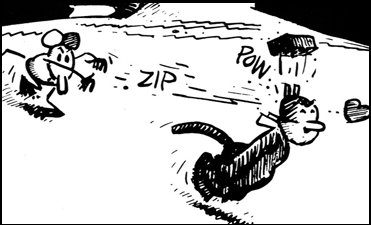
* Note: Uncle Jim was rarely wrong, but he is here. Ignatz was the brick-throwing mouse in the American comic strip Krazy Kat created by cartoonist George and published daily in newspapers between 1913 and 1944. It first appeared in the The New York Evening Journal, whose owner William Randolph Hearst was a major booster for the strip throughout its run. The strip focused on the curious love triangle between its title character, a guileless, carefree, simple-minded cat of indeterminate gender (referred to as both “he” and “she”); the obsessive antagonist Ignatz Mouse; and the protective police dog, Offissa Bull Pupp. Krazy nurses an unrequited love for the mouse. However, Ignatz despises Krazy and constantly schemes to throw bricks at Krazy’s head, which Krazy misinterprets as a sign of affection, uttering grateful replies such as “Li’l dollink, allus f’etful.”Offissa Pupp, as administrator of law and order, makes it his unwavering mission to interfere with Ignatz’s brick-tossing plans and lock the mouse in the county jail. The reference to the clock as “Ignatz” may refer to the popular descriptive term “Crazy as waltzing mice.”
Copyright 2012 Vic Socotra
www.vicsocotra.com
